Blog Archives
Obsidian Portal Campaign of the Month April 2024: Season of Strife

Twenty years after the fall of Utugash’s kingdom, a group of adventurers sail into Celestine and into their new destiny. Villains and allies of every faction eagerly await to use the newcomers for their own purposes, while even more sinister forces lurk in the shadows… Join us in talking with GM EdgarS as we explore the Season of Strife!
First off, feel free to tell us about the person behind the GM screen. Where are you from? What do you do aside from gaming? Alter Egos? Life partners? Family? Where can we interact with you on the internet?
Heya, I’m Edgar, I’m from the Netherlands, and I’ve been playing D&D for about 15 years now since I was invited to join a campaign for the first time. I really got into Critical Role around 2018 and watching it helped elevate my gaming and give me a way bigger sense of the possibilities the medium held to tell a story beyond ‘there’s a monster in the next room of the dungeon, go hit it.’ I also started DMing in 2018 and have or are running a couple of campaigns at the same time.
Before D&D I came from the world of tabletop gaming: building, painting and playing Warhammer Fantasy and 40K mostly, which really helped me get out of my shell as a teen (you gotta play with/against other people physically present on the other side of the table after all). From there it was a hop and a skip to D&D. I’ve been lucky to have had a pretty stable and dull life. The most I have in terms of baggage is experiencing bullying in high school because, well, huge giant nerd, but it’s precisely due to things like tabletop gaming and DMing I’ve gotten over that and grew to be a version of myself I enjoy, and being way more extrovert and bringing the sorely needed levity at office meetings. But yeah aside from that, I grew up in a fairly affluent household with loving parents, went to college (studied history and international relations), and after maybe a couple of years in the wilderness got a proper job recently working for the government. I even bought my first apartment a few months ago, which gave me the opportunity to set up a purposely-built storage room for all of my D&D terrain!

As for online, I used to be more active in various places such as tabletop gaming forums, but now I mostly lurk in peace and quiet, stay in my lane, and occasionally tweet out some art or dnd pics on my twitter (no I’m not calling it X) at @DCabbagefarm. That refers to Emperor Diocletian’s cabbages by the way. I’m a historian. Hi.
Tell us about “Season of Strife” in a nutshell. How did you design the world? What was your inspiration?
So the Season of Strife was born when one of the players put out a ‘looking for group’ call on Tumblr for an online d&d campaign, and I decided to take the plunge and offered to DM, back in late 2020. Not quite knowing whether this’d end up being a massive campaign or would bleed out early I decided to use the same homebrew setting I was using for my weekly campaign, the Twilight of the Spheres (and by the way, that one’s got its own Obsidian wiki too, probably even more expansive than the Strife one), but simply designing a new area for the world like it was some kind of Warcraft expansion. Exactly how many hidden continents are there?!
After this I expanded the map further, filling it out as I went until it reached its current state of completion, with enough space for a few more fresh campaigns. Here’s the full map, and be warned it’s a big boy

The first Twilight of the Spheres campaign (2019-2022) took place in the north-eastern region of the world, Eos, dominated by the Coalition (a pretty standard late-medieval European fantasy society consisting of a union of city states) and the Kyshtar Dominion (a majority dragonborn proto-industrial semi-Babylonian hodgepodge). That quarter of the map was all that existed of the setting, with no more than vague allusions to other stuff being beyond the boundaries. The new area I added specially for the Season of Strife was far to the south of it, an island chain called the Teylu Archipelago, inhabited by the Teylu eladrin & water genasi people who mix inspiration from both Polynesian culture and aesthetic, and Scandinavian and celtic. Two of the players are Scandinavian so that’s how that got included into the mix, plus the traditional celtic influences of the Feywild re: the eladrin. As a historian I like to draw heavily on history as inspiration for my worldbuilding, and regions in my setting often have some kind of ethnic or socio-political conflict. In this case it’s the colonial settlers who arrived from the Coalition and Kyshtar Dominion (collectively called ‘the Elyzians’) in the wake of a devastating flood that hit the Archipelago, and whose presence is pushing the Teylu to the margins. This conflict operates as a backdrop to everything going on in the campaign and it’s been very fortuitous that the players themselves chose to have a party consisting of two Elyzian characters and one from the Teylu, so that they could RP through these clashing perspectives and get a multifaceted view of the situation. Settler politics. Fun!
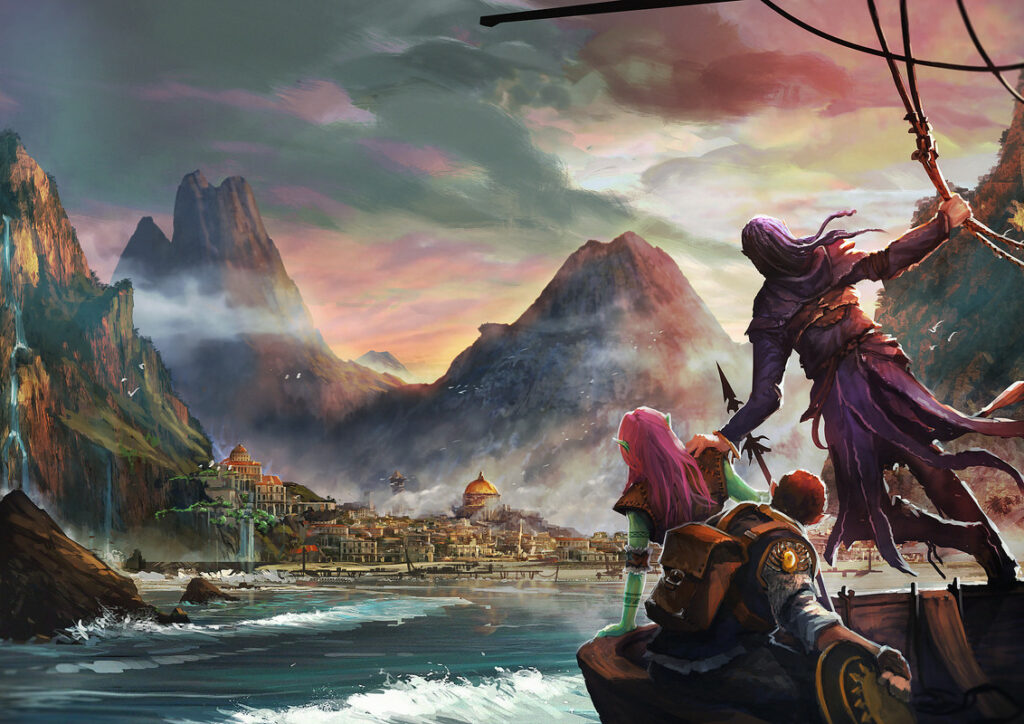
As for the outline of the campaign’s plot, in ancient times the Spring Court of the Feywild was cursed by the other season courts to slumber, and left behind buried in the material plane. However now a radical Teylu cult, the Teyhua, are seeking to awaken Spring and use its power to expel the settlers from the Archipelago. To do this a number of seals first need to be removed, which can each only be done by the Summer, Autumn, Winter and Spring knight (mortals in the employ of the courts as their champion, because they’re able to break Fey rules such as crossing running water and being able to lie), and the player characters find themselves entangled within this storied web and – mostly by accident – becoming knights for the fey courts.

I’m an avid worldbuilder, drawing heavily on historical minutiae, so in order to scratch that itch and build up a corpus of material I also write a “worldbuilder gazette” article every few months, dealing with info about the world that might not naturally pop up during sessions, such as how the different regional calendars work, lunar orbits, holidays, the economy, and nations the players haven’t visited yet. For every other worldbuilding-obsessed DM out there: I see you, I hear you.
How regularly do you play, and where do you play? Tell us about your current group of players.
The campaign is played online, using roll20 and Zoom, and we play about once every two to three weeks. With me included we’re a group of four from across the UK and west-central Europe. I’m gonna refrain from telling you too many personal details, but I’ll just say they’re some of the goshdarndamndest best RP’ers – nay, actors! – I’ve ever seen at any D&D table. They’re so insanely good. Sometimes I just shut up and listen for 30 minutes while they RP amongst themselves.
You put a lot of emphasis on the factions in your game, enough to place them on the front page. Can you tell us how important they are in your game?
As mentioned previously, I draw a great deal from history when worldbuilding, and if anything history is a revolving door of peoples, polities and cultures clashing with each other. The factions on the wiki’s home page are for the most part the main cultural groupings; what background an npc is from can inform a massive amount about their character, customs and perspective on things, especially how they relate to the local background conflict and what that means for their relationship with the player characters. I don’t want to have my game world populated by unattached caricatures, I want the npcs to have allegiances of their own – be they culture, country, ethnicity, etcetera. In my opinion they make characters richer and more vibrant, and give the players an additional set of approaches to relate to them (are they from a rival faction? Are they both foreigners away from home? Do they have certain proclivities or interests relating to their culture that might be used to sway them?)
I don’t want every country to be contained in its own cordoned-off little box either, like they’re in their own stasis bubble: People move! Countries do war, trade, diplomacy, propaganda, cultural exchanges, religious exchanges, espionage, migration and more! Interactions between the different factions are the building blocks of my world, and the quest design flows organically from that. Part of having a reusable setting is having background conflicts that continue to passively generate animosity that can be leveraged into new quests. In the season of strife campaign the main plot is almost entirely motivated and impacted by the background conflict of the indigenous Teylu being squeezed by the Elyzian settlers, and most quests and npcs are at the very least tangentially related to that. Most recently the players were sent on a little sidequest to solve a dispute on some Teylu islands where wealthy Elyzian settlers had built… well… the Hamptons, basically, and their mayor was secretly throwing meat into the bay to lure sharkfolk to the local Teylu water genasi village’s spiritual site to disrupt their traditional links to the land.
I’ve also been working with a couple of artists whom I have commissioned many times. One of them is designing the factions icons for me. Those icons are all unique and purpose-made for my setting, not just plucked from the web! The faction icons there are the ones that are currently done, but in the end there will be two to three times as many! I’ve currently got a plan in the works to start a project with these artists, in order to make an illustration of one or two “average joe”’s from each main culture, to create a kind of setting sourcebook and give an idea of what the regular person in the street of each nation would look like.
Your WIKI section is very detailed and quite comprehensive. Who is responsible for adding the information and organizing it? How much time do you spend updating it as the campaign progresses?

Your WIKI section is very detailed and quite comprehensive. Who is responsible for adding the information and organizing it? How much time do you spend updating it as the campaign progresses?
L’wiki, c’est moi. It’s all done by me and I’ll conservatively estimate “a metric ton of time”. It’s a good thing I enjoy wiki-building (I read aloud from my hostage note) and I’m a glutton for punishment if nothing else. My players do help me out every so often with writing sections of the summaries if I don’t have enough time to finish them, and one of my players performs vitally important recording wizardry, making video recordings of the session and uploading them to a private youtube playlist so we can watch them back and use them to make summaries. And she also makes thumbnails for each session! Recently we also redistributed some tasks so that another player would help me out with writing the short synopses.
Your campaign has many items and makes great use of Obsidian Portal’s Items section. How do you feel the extra work it takes to implement this benefits you and/or your players?
It’s always good to have a central place to store data as a master reference. Handing out item cards or putting them into word documents or reading out the item descriptions is all well and good but you can almost guarantee that stuff’s gonna get lost or misplaced at some point. Much better to have somewhere you can always refer back to. We also have a few items that have become real staples of the characters’ iconic look, such as the sword Spring’s Edge, one of the first items the group acquired in the first ten sessions, and it’s nice to be able to give these items an image to represent them.
What made you choose D&D 5e as your gaming system? Have you played other gaming systems, or earlier editions? How do you feel it compares?
I played 3.5th edition in the first campaign I joined (playing for a good 13-14 years) and DM’ed it for a while, and gods above and below in hindsight I found it so cumbersome and bloated, with hundreds of sourcebooks and a level of stat block number crunching I was simply never going to be able to get a proper grip on; After a while you get monsters on the field with modifiers of +20 to hit, and if you overshot the challenge rating you were supposed to give the players by a bit you could quickly end up with foes the characters could literally do barely more than single digit damage to. And worse, I disliked how lower level spells became exponentially useless as time wore on, because both the DCs and effects of those spells remained as low as a low level character casting them, encouraging you to only throw your highest level stuff. I could probably go on for a while but I’ll save the internet the byte space.
In comparison the 5th edition rules are easy enough to follow that I learned them simply through watching/listening to Critical Role, picking up most of the game (and learning answers to some of the baked-in rules conflicts or less commonly understood features) before ever even opening the Player’s Handbook. The familiarity I now have with the system appeals to me, the basics are pretty easy to follow, flexible enough to homebrew off of, and combat can be balanced quite decently on sheer ‘vibes’ alone, while fixing a lot of the annoyances I had with 3.5 (I don’t think any annoyed me more than being unable to move more than 5ft and make more than one melee attack, turning most battles into stationary ones because it was actively detrimental to move). The system is also robust enough that you can overshoot and make monsters too strong, without instantly signing the players’ death warrant.
How much time is usually spent preparing your game sessions? Describe a typical session.
Most sessions take me a couple hours of prep, often about equal or slightly less than total playtime… except when I need to build a battlemap in Roll20, which can eat up hours of my time while I finetune tiny details. Regardless, my prep can often be described as “leapfrogging.” Whenever I prep a session I will inevitably have enough material that we end up covering (nearly) two sessions with it. Plus if I need to buy time, I’ll just let the player characters talk to one another. Bam, there’s half an hour filled, easy peasy. In our very latest session the players started right after having been portalled to the gates of a Feywild city. They were right in front of the gates! It took 30 minutes before they even walked up to the guards! It’s a miracle we get anywhere at all.
Can you please explain the difference between your session summaries and your miniature session summaries? What is the difference between the two types of sessions?
Those both relate to the same sessions. The ‘session summaries’ are the long versions – which are probably a little too long at times, sometimes reaching more than 10 pages and rarely less than 4 – and the ‘miniature session summaries’ are brief synopses about one paragraph long. It’s a practice I picked up in the first campaign that I ran, where I noticed players had difficulty recalling the basic outline of the few sessions before it (especially because that campaign only played once every 6-7 weeks or so), so the mini summary contains a very basic outline of the main events/facts of the session, just so you can more easily search back for when something happened and so you can recall the basics at a single glance, rather than walls and walls of text. The mini summary section on our wiki then links to the long-form summary of that particular session.

I’m a bit of a fanatic about chronicling everything in massive detail because:
A) I’m a historian and work with archival departments at a government ministry. It’s kinda in my blood at this point.
B) The first campaign I ever joined as a player ran for like 12-13 years and we had basically zero documentation, so halfway through there were just complete year-long arcs of the campaign I had no recollection of or where I didn’t know the order of events anymore, so a lot of plot stuff inadvertently flew over our heads half the time because we didn’t remember anything.
C) I just can’t stop myself. Help.
How long have you been using Obsidian Portal? What brought you to the site and what keeps bringing you back?
I had an account before then but I’ve actively used Obsidian Portal since about 2018, when I first started DM’ing my own campaigns. There might be shinier things out there, with widgets and gadgets and holograms, but I like the easy legibility Obsidian Portal’s format provides if you wanna put up big blocks of text. With some pretty basic coding you can do a fair amount to make it look nice, formatting it like it’s a Wikipedia article. And of course being able to hyperlink back and forth between different pages makes navigating through the wiki a breeze.
If you had to pick just one thing, what would you say Obsidian Portal helps you with the most?
I put up stupid amounts of text, and like I said above I like the legibility Obsidian provides. As a history enthusiast my favored terrain is wikipedia pages (I get a +2 to hit modifier against other historians), so that’s the model I like to copy. I’m also happy with the pre-defined sections for characters, game logs and items, rather than needing to build custom wiki pages for each of them and it becoming a right old mess. If there’s anything else I might want to see from Obsidian Portal it’s one or two more sections like that, such as a bestiary section for common creatures/creature types found in your setting.
What would you say is the biggest highlight of your game so far?

Oh gosh, oh golly, oh jeepers, I had such a tough time answering this question!! We’ve played 74 sessions up to this point, and so many exciting things have happened! Should I pick the time the cleric held an impassioned speech before the church to denounce the bigoted high priestess? Or the victory in the Autumn Tournament when the rogue defeated the other candidates to become the new Autumn Knight? Perhaps I ought to pick that time the party were surrounded by enemies on all sides and opened up the Iron Flask they’d carried with them for nearly 30 sessions without knowing what was inside, summoning a succubus to their aid? That time the ranger/druid had a romantic ride across the meadows of the Feywild on the back of a stag with one of the main villains (he’s hot so it’s okay), or simply when two players were wasted drunk and trying to escape across the rooftops from some bandits, with the air genasi rogue floating away from danger like a balloon?
This artist has done a huge series of illustrations for our campaign, all of which can be found here
I guess if there is one moment I had to pick it would be in the earlier stages of the campaign when the players were at a fancy gala, and the rogue suddenly ran into the crime boss (and secret weretiger) on the dancefloor whom she’d been romancing at the start of the campaign before getting cold feet and breaking it off. I cannot describe the utter mic drop moment when that French accent suddenly returned and I showed off the art I had commissioned for the occasion:

As an aside I also want to add that for me the personal highlight of any game is when the ranger/druid communicates with any flora or fauna. I never know what voice will come out of my mouth but let’s just say the interactions don’t really live up to the wise, sage druid image. Pigeons hate her, seagulls have died for her, trees want to practice their stand-up comedy routines on her.
Okay, as a last question, we always ask for the GM’s “pearls of wisdom”. What GM insights can you offer the community this month?
I mean you’re gonna hear this one repeated ad nauseam, but communication really is key in playing a game like this. You gotta have some people at your table you can trust you can talk with like adults, make sure you’re on the same wavelength as to what kind of game you’d like to play, and make the players feel you’re playing with them not against them. Though as a DM I feel you should always reserve the right to not acquiesce to every single thing the players might ask for; sometimes mother knows best.
However, apart from slam-dunking that low-hanging fruit into Tantalus’ head, there’s a couple more things I’d like to add: First off, the success or failure of your campaign can lean very heavily on what the players are like, irrespective of your quality as a DM. There’s something Brennan Lee Mulligan said at a DM roundtable a couple years back that’s always stuck with me, namely “there’s nothing you can do if the players don’t care.” You can be the best DM in the world with the coolest party tricks and goblin voices but if there are sacks of potatoes sitting opposite your screen it’s gonna be a bad time (and I don’t mean people who are simply shy or withdrawn, I mean people actively unwilling to engage or care). And conversely if you’ve got some people who come to the table with a good attitude, are willing to engage and have a good time, you can elevate any game to beyond what it is on paper. I’ve had about half a dozen campaigns in my DMing career and I’ll earnestly admit some are running better than others (but on the whole I’m very happy with them all), but there’s one that thankfully bled to death where I was straight-up not having a fun time, because of a complete unwillingness from half of the table to engage, like they were forced to participate against their wishes. I didn’t DM that game any differently from my other campaigns, but it was a rotten experience while my other campaigns give me a surge of energy at the end of the night. You’re playing a collaborative game and that collaboration is what makes or breaks a campaign.
Secondly, being behind the DM screen gives you certain insights into how the game functions, and you can try to transfer some of that wisdom to your players to help them get better/get more out of the game. If you have players at your table who are DMs themselves you’ll often quickly notice they play a little bit differently that other players, and in my experience they tend to be a bit better with spotting plot hooks, unearthing crucial info buried in a piece of dialogue, and jumping on opportunities to give the scenario a different twist. With a little encouragement and advice I’ve seen the folks in one long-running campaign in particular transform from ‘enthusiastic amateurs’ into model players. If you wanna give your players any insights to help their play, I’ll offer you this one: “If you don’t do anything, nothing happens.” This applies to every aspect of the game. If you don’t respond (promptly) when the DM asks you about scheduling, the game doesn’t happen. If you don’t go talk to that npc who seems to hold a potential plot hook, then that quest doesn’t occur and you don’t do anything during the session. If the rest of the party is chasing the undead who just attacked the village and kidnapped someone but your character doesn’t want to leave their bed (this happened once), you won’t be able to do anything in the game for the next hour or more. If your character is getting distorted visions about their personal quest but is informed they first need to consume the waters of life to see them more clearly but you make no move to acquire said waters of life, nothing happens. If you never take the initiative to turn to your fellow players and go “hey I think we should plan a heist to steal the plot item”, then no fun shenanigans-filled heist happens. If you play the game super safely and cautiously, none of the fun stuff happens. D&D is an immensely malleable game, where your efforts as a player can and will shape the contours of what the session is gonna be like: Make your players aware they have that power and co-opt them into making the game more fun and to try and get them to engage with what you’re putting out for them.
Thirdly, based on my own campaigns so far and the ones I’ve participated in as a player I’ve picked up a way to structure my campaigns that I’m quite happy with, and that I’m using for the second Twilight campaign. If I could do Strife again from the start I’d have liked to use this approach there too. I like to start by taking my time with the lower levels – giving players enough time to fully explore all their spells and class features and ways to use them creatively, and making them appreciate their new abilities more when they finally get to level 5 and beyond – and giving them a pure sandbox game. They’re set loose in the world and allowed to do generic low-level quests: Root out the goblins blocking the local road, escort the archeologists to the nearby excavation site, find out who’s stealing from the warehouse, etcetera. They get the sense of fulfillment of completing quests (rather than just subsections of a long-running main plot), get to explore your world and setting, get to build a network of NPC contacts, and have complete freedom to pick and choose for themselves what to do. This also puts them at liberty to fail or abandon quests without the stakes being too high and introduces the players to the idea that “if you mess up, you make a mess”, because at a certain point in a high-level plot the party can’t really be allowed to fail that much anymore without endangering the entire setting… and DMs put a lot of work in their settings! They don’t wanna toss it out on a whim! So this early sandbox stage both gives the party freedom and gives the DM freedom not to have to plot-armor the party. In the Season of Strife the party spent their first ten sessions in the starter-town, Celestine, engaging with a local crime boss (slash love interest), and then hitching a ride on an archeological expedition to another part of the island for a while and doing a bit of dungeon delving, before they got involved in the bigger plotlines. You can also start throwing in subtle foreshadowing to the campaign’s eventual BBEG… A namedrop here and there, a whispered rumor, mysterious graffiti appearing in the cities, and so forth. After the sandbox stage you’ll start reaching levels 6, 7, 8 or so, which in my opinion is the game’s sweetspot. This is the part where the format becomes more plot-driven, your players may encounter recurring villains (possibly lieutenants to the campaign’s BBEG), and the stakes start increasing. Perhaps this stage results in a kind of mid-campaign climax. A big victory for the players to revel in at the end of the second act. Maybe you’ll even return them to the sandbox stage for a while to do sidequests or loose ends, before the plot and stakes start dramatically ramping up again as the BBEG starts coming to the fore and you get to the big, epic, dramatic battles as you work your way to the final confrontation. Players generally don’t like losing more than once (in a row), so my recommendation is to always split up your plot into separate portions which can be won piecemeal.Also, get theater kids to join your game. They are good at roleplay and drama. It’s… it’s in the name.
Thank you to the community for making this campaign of the month possible! That’s all for now, join us on our next adventure May 1st, and don’t forget to nominate your favorite campaigns for our next Campaign of the Month!
Obsidian Portal Campaign of the Month February 2024: Cyberpunk 2077 Fate Accelerated
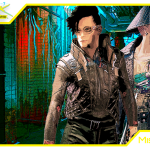
Welcome to a futuristic world where corporations control everything from their skyscraper fortresses, enforcing their rule with armies of Cyborg assassins. Gape in wonder as the player characters track down a Combat Cabb in Dog Town, using cyberenhancement and cutting edge technology in HumAnnoyd’s latest High Tech site, Cyberpunk 2077 Fate Accelerated!
You are no newcomer to this forum, having won several times before. Some people may know you already, but for those who don’t, how would you like to introduce yourself? Anything new going on?
I am an artist, designer and animator who has made a living in video games, tech, education, and marketing. Inspired by Tolkien and Star Wars I started playing RPGs in the late 70s with the Holmes Edition of D&D and ran my first game using Traveller’s “little black books”. In the 80s I picked up Cyberpunk 2013 and ran a seven-year campaign using it and CP2020. This year has been trying due to an intense battle with cancer, but it looks like I am on the mend and may just beat it yet.
What new approaches did you take when designing your site for this new game? Did you adapt old templates or start with an “empty page”?
This website was a little different than my others. During the pandemic I was put on furlough, so I started working on writing rules for a Fate Accelerated version of the video game based on the Dresden Files Accelerated rules. To prevent losing my mind in boredom and to keep my design skills sharp I decided to lay it out in InDesign, using an aesthetic inspired by the amazing artists of the video game. I built the OP Site after that, trying to recreate that aesthetic online.
Are your players new, or have you stuck with players who have been with you in previous games? How often do you play? What are your sessions like?
My roommate and his cousin both expressed interest in playing CP2077A and have little experience with RPGs and none with Cyberpunk. We have played the first two sessions in person but, due to busy schedules will be using Discord and Roll20 going forward.
The sessions have been quite fun so far, with both of my players being creative and clever. I cannot wait to see how the campaign develops as they gain more confidence and experience! We also have a couple of people who may join the game soon.
You are obviously a big fan of the Fate Accelerated Game. What do you like most about it, and in what ways does Cyberpunk 2077 differ from Emerald City: Requiem, which won Campaign of the Year in 2022?
I think the primary difference is that DFA is a full game with rules out of the box. I had to write and create rules for the CP2077A game which required a lot of picking and choosing from Fate’s vast tool sets and games as well as innovating my own ideas. The Emerald City is also set in a city that the players all participated in creating while Cyberpunk is the creation of Mike Pondsmith and the amazing team at CD Projekt Red. What I love about Fate Accelerated is that is such an easy system to hack and for new players to grasp. It also gives players agency to flourish narratively and with much more freedom compared to many other RPGs.
Your choice of artwork throughout the site is great, but it looks like you manipulate each image to give it your own particular flavour. Can you share how you go about this, and what sort of tools you use in your “touch up” palette.
The images are all taken from a mix of screenshots from the video game and photographs blended in a long and involved process in Photoshop that I have been honing for over a decade now. I use an arcane mix of smart objects, filters, actions, blending modes, layer styles with some painting for the final touches that results in massive file sizes of 3 Gigs or more. I am constantly changing and adapting my process as I learn new things.
Tell us a bit about the Cyberpunk world. Boostergangs, techies, outriders, Maelstrom gangers, roadwarriors! How do your cyberenhanced players interact with these characters? Where are they heading?
My players are involved with the 6th Street Gang whose leader just died under mysterious circumstances. The heir apparent of the gang asked them to quietly track down one of his missing friends who went missing along with his expensive Combat Cabb™ in Dog Town, the walled-off combat zone on the edge of Night City that is run like a fiefdom by an ex-soldier who betrayed his masters. The PCs have managed to use some impressive cybernetic implants to infiltrate a business and track down the Cab’s GPS signal to a garage held by the hated Scavs gang. I cannot wait to see how they will carry out the contract and the repercussions that will arise from their actions.
Do you get help from your players in adding to the site content? Or do you do most of the “heavy lifting”?
For now, I am doing all the writing and art and creating for the game. I am hoping that, as my players become more adept at the game, they will help with that “burden”.
You have obviously been with Obsidian Portal for some years. In recent years, many gaming platforms have come onto the scene. What keeps you “sticking with” Obsidian Portal.
I love Obsidian Portal’s ease of use and adaptability with CSS. I am constantly pushing myself to do something new and better with my sites and OP has always risen to that challenge for me. I also enjoy the community who are all a great help when I run into a snag with CSS or provide feedback on a design choice.
If you had to pick just one thing, what would you say Obsidian Portal helps you with the most?
Organization. Having written my own rules for this game OP has proved invaluable for keeping them organized and easy to access for my players. As the game develops there will be more and more NPCs to track and that is so easy using OP.
What would you say is the biggest highlight of your new game so far (please also provide images and links if possible)?
I think the best part of the game so far is when my players started realizing how much freedom they had in the game. They were wanting to infiltrate the Combat Cabb™ garage and came up with a good plan to do so with little to no prompting from me. The infiltrator had to improvise and role-play a fair amount to make it all work and my players did so despite having had little experience with RPGs in the past.
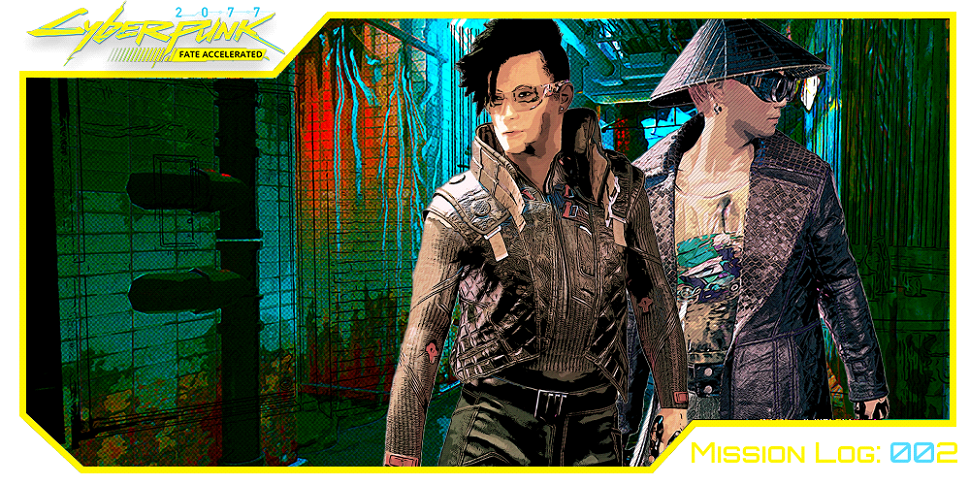
Okay, as a last question, we always ask for the GM’s “pearls of wisdom”. What GM insights can you offer the community this month?
I strive to always stay flexible enough to be able to react nimbly to my players’ choices and plans while at the same time providing enough narrative structure to keep the story interesting and fun for us all. It is a very delicate balance that benefits from trying to never say “no” to my players. This gives the players a greater sense of ownership of the game and agency to be truly creative. I admit that I sometimes struggle with it when I get too attached to certain ideas or storylines, but it is always my goal.
END
OBSIDIAN PORTAL CAMPAIGN OF THE YEAR 2023!
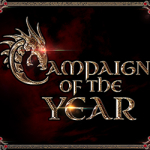
WINNERS FOR 2023:
First Place: Elvathadrin with Torg: Rise of the Storm Knights
Runner Up: Lord_Sam with Esomor Prime
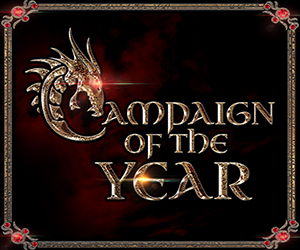
It’s that time of year again- you guessed it, it’s Obsidian Portal’s Campaign of the Year 2023! It’s the ultimate showdown between some of the best of the best Obsidian Portal has to offer: The winners of our Campaign of the Month 2023! Voting is open to anyone who wishes to contribute- be sure to keep an eye out on the OP Community Forums, the OP BLOG, Facebook and Twitter for more information!
We have some great prizes in store for both the first place winner and our first runner up! In addition to winning Free Ascendant membership time, this year we have some AMAZING prizes generously donated from some of the best in the industry, including Paizo, Frog God Games, Limitless Adventures, Crit Academy and Mongoose Publishing!
FIRST PRIZE includes:
– Digital copies of both Starfinder and Pathfinder Second Edition Beginner Boxes and/or Core Rulebooks from Paizo,
– Physical copies of Traveller Core Rulebook and the Paranoia Core Book from Mongoose Publishing,
– Digital copies of Limitless Encounters 1, Limitless NPCs 1 and Limitless Monsters 1 from Limitless Adventures,
– A gift certificate worth $200 to select any digital items in store from Frog God Games,
– Physical copies of Bountiful Bounties and Aelx’s Bombastic Oddities from Crit Academy,
– 1 Year Ascendant Membership from Obsidian Portal
RUNNER UP PRIZE includes:
– A gift certificate worth $100 to select any digital items in store from Frog God Games
– 1 Year Ascendant Membership from Obsidian Portal
A huge thank you to our sponsors for this years prizes!:

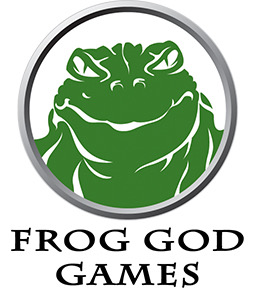
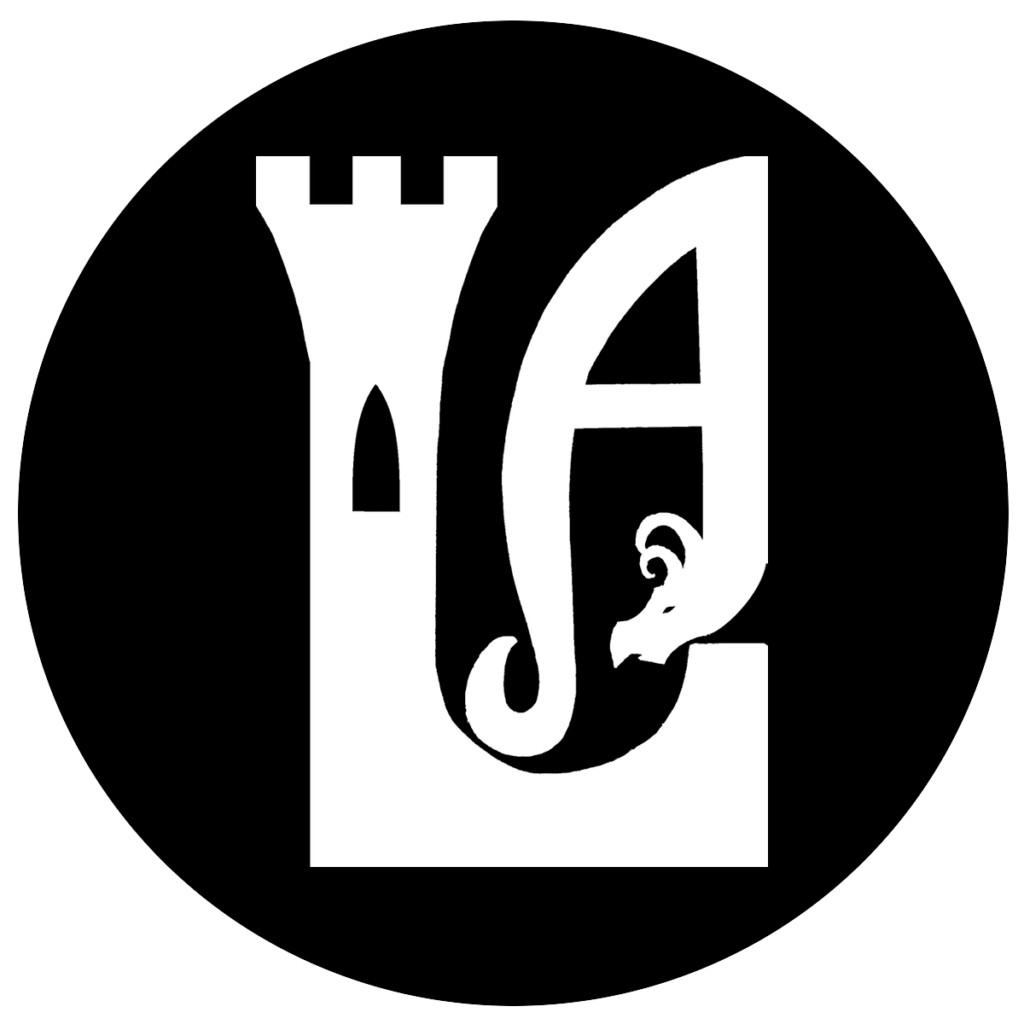
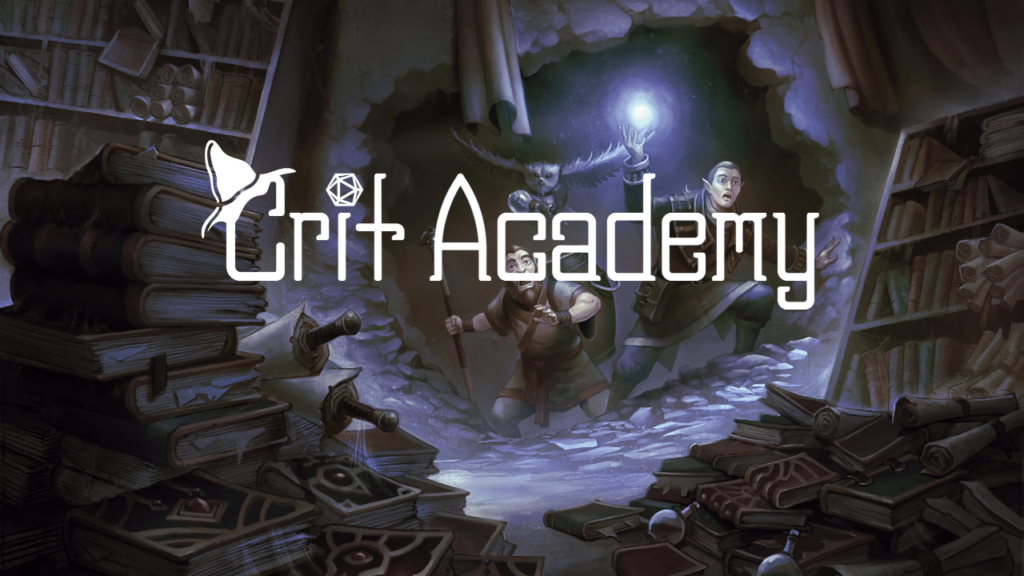

Obsidian Portal Campaign of the Month October 2023: Thieves & Kings
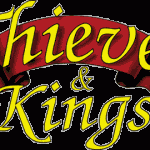
Well met and welcome to Argoth, the land of Thieves & Kings — our October Campaign of the Month winner! GM Robling is no stranger to our crown of conquerors, and adds to his accolades with some of the best world-building and writing you’ll read this side of the City of Bright Sails. Thieves & Kings has been many years in the making and promises to take adventurers from humble inns to fey courts to powerful portals into the realms beyond understanding. Warm your worn hands by the common room fire and listen to our tale…
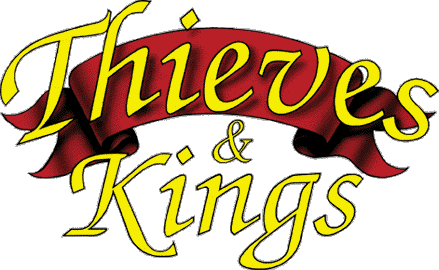
What’s new in your life since your Campaign of the Month win in 2014 for “Battletech (Farscape): The New Breed”?
Practically nothing, though, fundamentally, COVID changed all our lives, neh?
“Thieves & Kings” has many chapters and hundreds of gaming sessions spanning seven years of real time. We know it would be impossible to sum up everything, but could you give us an overview of the story, so far?
Overview, hmmmm. It started with six players, each representing a character, who had been fostered for their youth to various clans across the realm of Shem, being informed their adopted father had died and left them his farm. They gathered and discussed matters, and were immediately involved in an assassination, and fled the town of Hexwater a few steps in front of the local law. Over the next few months, they established themselves in the region of Thornkeep, and discovered the local mystery around a troll invasion, the local fey creatures, and mistakenly (?) began hunting a former fey hag as their chief enemy. As the years progressed, they began to acquire divine powers and discovered that their former enemy “Blackmaw” wasn’t so bad, really, and that she was fighting someone who was far worse, “The Great Hunger”, her former lover. At present, the survivors have decided they wish to embrace these offers of divine power, and are sorting-out how to achieve true divinity as a Demi-God. But their enemy, The Great Hunger and his followers, know them and work to unravel their plans as they unravel his.
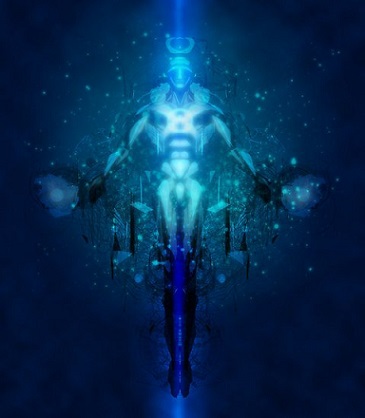
The continent of Argoth and the world of Kethira as a whole is extensively catalogued in your wiki — it’s a veritable library of information that has been built up since your school days. And the character section is absolutely full of people and stories. What were your favorite bits to write and what parts of the site do you find most useful?
It’s extensive because of the years of effort both I and my players have placed into it. The efforts of today’s campaign reflect in the campaigns to come, and that forms a very wide amount of information that never makes the WIKI or Portal files, but exists, nonetheless. The ability of the Obsidian Portal website allows a wide disbursement of information, including bios, stats and even connects them to items and other characters, because each has their own story to tell and share. I’ve found if you approach each NPC as a real person, and treat their reactions as real and honest from *their* point-of-view, it enriches the encounters with the players, and then influences future encounters.
At the end of the wiki for “Thieves & Kings” there is a section on customized rules for the campaign — many adapted from various supplements and systems and modified to fit your needs. The Rulership and Thieves’ Guild Operation rules were especially interesting. How have these worked out for you and your players during the game?
I established each for the players to read and decide which version they wished to implement for various campaign management operations. Most were discarded, as the group slipped away from large-scale management of armies and realms, and decided to concentrate on small, close-knit organizations of their own, dealing with dozens of people, rather than hundreds. The “Thieves’ Guild” operations remain important, as one of the players has worked to establish their control over the underworld of Mornhaven, and allows us to abstract that aspect of the game enough to concentrate more on the role-play and combat. Which was kinda the point of them, really.
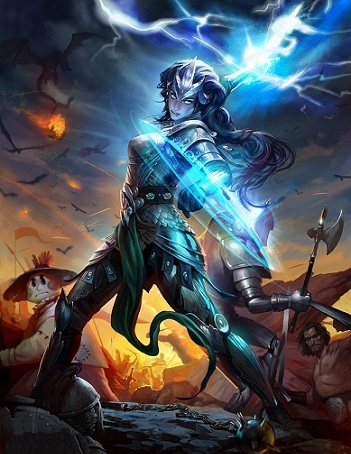
According to your Obsidian Portal bio, you have tried out many game systems and have a lot of experience with a variety of settings and game mechanics. From your perspective, what are the advantages and disadvantages of 5th Edition D&D compared to other games? Was shifting Argoth from other editions into 5th Ed. a challenge? Are there any plans to convert it into other systems in the future, if needed?
The advantage of 5th edition, I feel, is that it remains very robust in sliding back and forth between combat and role-playing, and allows exploration to be easily adapted to the encounters. If you compare it to early editions, it allows a great deal of mobility and movement to combat, which allows players to shine, rather than simply two characters beating on each other, whittling away HP as they go (*Cough Cough* 2nd Edition *Cough*). Pathfinder is nice, but too dependent on Prestige classes and Feats determining each encounter, whereas 5th Ed allows simpler math and makes the combat flow swiftly. I don’t think we’ll be transitioning into D&D One anytime soon, if ever, and the recent “home rules” introduced by Larian Studios “Baldur’s Gate 3” are intriguing and show how simple rules changes can make a difference in playstyle and encounters, and bears scrutiny.
The Adventure Logs for “Thieves & Kings” feature a clever format — a quotation, an inspiring image, and a video link to help set the mood. Are these atmospheric touches selected prior to a game session or afterward? Do you find that reinforcing the moods or themes during gameplay to be important or is it better to let the players create their own impressions?
I have found my players don’t typically pay much attention to them, until suddenly in the middle of an encounter they remember the title of the episode, or the picture, or the video, and it all falls into place in their minds. That’s the point of it, really, to hint a little and to provide some real physicality at a key part of the episode. Sometimes, however, they ignore it completely, and go out into left field, and the title proves irrelevant, as they choose to follow a new line of investigation from what they said they wanted to at the end of the last session. But that’s okay, because, ultimately the Players have the power, and choose where they want to go and what they want to accomplish. I simply provide options.
As to mood, I’ve found sometimes that you can lead the players to the encounter,and set the mood, but if they’re not into it, they won’t care. Sometimes they just want to chew gum and fight, and they forgot their gum.

What have been your favorite moments in the campaign, so far?
The sudden realization that one of the main characters, Blackmaw, wasn’t really so bad after all. She’s unabashedly NE, but they have accepted her as an ally, because she doesn’t see them as rivals, and sometimes they prove to be useful pawns to play. Her reveal of her love for her monstrous children to the party was especially precious, and one of the players said it was the highlight of the campaign to her. “Blackmaw” is my favorite NPC of all time.
Also the moment they were confronted with the knowledge there were actually seven children raised by their father, and they had another “sister”. At that point, they realized that the place they had been investigating was called “The Hall of Seven”; and they realized a truth they had known for months, but never clued into. Later, she swindled them to acquire a magical artifact with them, and during that reveal, they realized they’d been utterly taken advantage of, and never trusted anyone for a long time afterwards. They really didn’t like or trust her for a long time, though now they are openly working with her. “Skazzy” is a favored NPC this campaign.
Without giving too much away, what hints can you give us about the plans (if there are any) for the conclusion of the tales of “Thieves & Kings”? Or is this the kind of adventure that might go on for as long as possible?
The players know the ultimate goal of the campaign is to achieve demi-godhood, and the defeat of The Great Hunger. Only a couple of levels away from that, they understand their goal, and know that their characters are going to become demigods in the campaigns to come, so they have a vested interest in achieving this goal. Back when they gained their first “Divine Level”, they established the path of their cult, and its worship, and now it’s all about following-up with this to achieve their proclaimed status. We just started talking about what the next campaign might be…
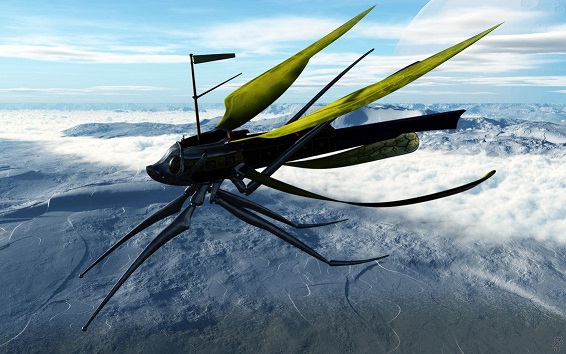
During your first interview with Obsidian Portal for your prior Campaign of the Month win, you wisely advised GM’s to avoid being adversarial and to “Be the storyteller, and make the players the focus of the campaign.” In the years between then and now, what other insights have you gleaned regarding the craft of game-mastering, writing, and world-building?
Don’t plan too much. While I run an open-world campaign format, and for the most part, the players are quite willing to stay close to home. They really have so much to explore closeby, that they don’t *need* to travel much. Just have a couple of adventures handy that you know well and can adapt on the fly, and apply, whenever the players decide to “go rogue”. And they will go rogue on you in an open-world format. Otherwise keep plenty of notes so you can allow them to explore the world around them, and forge their own destiny. If you have notes from previous campaigns handy, they can travel over lands from previous campaigns, and realize what their previous characters have done, and how much effect their actions have at the moment and reaching into the future.
If you want the Players to travel, provide them with the means; Teleport Circles and Flying Boats (Spelljammer), or even just normal boats, allow them to travel extensively and explore across the worlds you design, and let them explore other genres of gaming, such as Oriental Adventures, Fallen Empire ruins and even isolated rocks in space at need, and give them a tie to the campaign world that they will treasure and love. In this campaign, they adore their flying ship, the “Emerald Angel”, improved their ability to get across the map quickly, rather than slogging across mountains for weeks, they can travel across the planet in days, or reach the markets at Mornhevan in a couple hours, rather than a couple days, making them able to concentrate on the task at hand, rather than the means to get there.
Otherwise, my campaign advice remains the same, keep it open-world, keep copious notes, and let the Players explore themselves as they explore your world, and they will develop the stories you will replay and talk about for decades.
Thus concludes our tale of Thieves & Kings, for now. Our thanks to Robling and his Players, once again, for sharing their creative might. Go forth now, fellow adventurers, with this edict: find us more worthy campaigns upon which to cast our eyes, so that our circle of judges may bring you fresh insights and inspirations. Bring your treasured discoveries to the forums, here.
Obsidian Portal Campaign of the Month August 2023: Theophagie

This month we take a step back in time, joining GM AshleyMcdniel and party in their campaign, Theophagie. Set in the Iron Age, Theophagie explores a world impacted by an event known as the Theophage, where the majority of the male Greek Deities were killed, leaving large power vacuums and spawning the creation of matriarchal societies throughout Greece and Gaul. Here the Gods and aren’t just concepts- but real beings that walk the earth and see fit to involve themselves in mortal affairs. Join us in talking with GM AshleyMcdniel as he shares his insight, tips and tricks!

First off, feel free to tell us about the person behind the GM screen. Where are you from? What do you do aside from gaming? Alter Egos? Life partners? Family? Where can we interact with you on the internet?
My name is Ashley (He/Him) and I live in San Antonio, Texas. Besides table top RPGs I also play Magic and Battle Tech. I also enjoy swimming, fishing and target shooting. I live with the love of my life Charlie (they/them.) If you wanted to chat about gamming you can PM me on Discord at scarecrow#2992
Tell us a little bit about the setting of your game. What made you choose our own world for the game?
Theophagie is an anachronistic game set in Europe. It is a way to explore the myths and legends of several cultures and ask see how they interact. A friend of mine name Josh found obsidian portal and introduced me. I feel in love and have been using it ever since.
Tell us a little about why you chose Dungeons and Dragons 3rd edition for your game system. How do you feel this system supports the type of game you are running?
I have a lot of fond memories of DND 3.5. However, it is not without flaws. I looked at it as a place to start and made a huge amount of home brew to change the flavor of the game. DND 3.5 has a huge amount of very high-power class and feat combinations. I wanted to have a more dangerous, high risk feel so I made all new class progression, level progression and an array of feats that allowed for that. Then I used my player base to provide feedback so they had input and buy in to the world and its development.
Let’s talk about the visualization of your campaign. What made you choose this design (color schemes, banners, dividers, etc.)?
The design really started with the picture of the trireme on the home page. The red, white and black made the picture pop. Then we just stuck with that.
You chose to share your design with the community and release the CSS code. It was so important to you that you placed a link to it on the home page of your campaign. You also give credit to the artist whose images you used by linking to their work. Why was this important to you?
The code part is easy. If someone wanted to know I did something they can just look. Now for the art. So, I have quite a few friends who are artists and work on commission. Now the first campaign in the setting was run in Gaul that was under Greek influence. I was looking around the internet for pictures of gods and found a wonderful picture of Hera and loved the style. I tracked down the artist and looked at the rest of what they had done and fell in love. I found their contact info on Deviant art. Turns out they live in France. Messaged them on FB and paid them to use it. They up to that point had just done it for fun and told me they had never been paid like that before so that made me feel pretty good. Since then, they have even published a book and are selling it on Amazon.
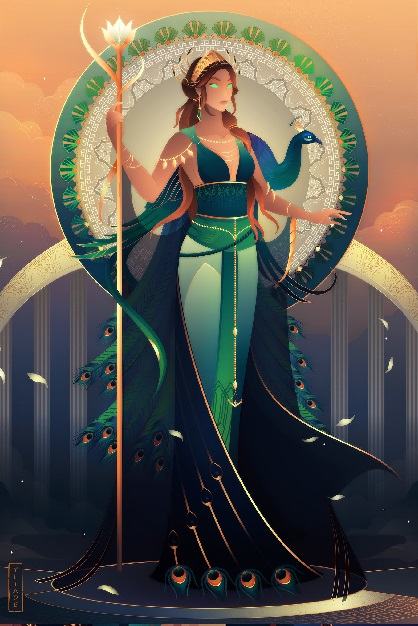
You have given a great deal of thought to the integration between your game system and your settings. Tell us a little about this integration (for instance, classes are limited by location).
Well, I wanted each nation to be an opportunity for a different flavor. So, the way the magic classes work in Egypt, Britain and Greece are all different. This also means that each God has a different type of connection to their disciples. I felt it was natural for Druids to be native to Britan and Bards to be native to Scandanavia. After doing some expansion and talking with my players we all collaboratively figured out what classes belong where and leaned into the mystisim from that area for insperation.
Tell us about your change log in the wiki page. Why do you keep it and why is it public?
The players wanted to be kept up to date about additions and the feature was a useful way to do that.
Tell us about the Adventure Log. You seem to have run several games in this setting already. How does that work? Do you play several games at the same time? Or one after the other?
The first game was centered around Gaul. After that Campaign was over one of the PC’s had died. One of the players Josh very much wanted to run a game in the setting so he took the second adventure. It was a sailing adventure in which we took the body from Marseille to Delphi so we could get the gods to resurrect them.
Tell us about the way you arrange your characters. I see characters have few tags with names. How do you keep track of the NPCs? How do you know the context under which each NPC was created?
The NPCs are any person have the opportunity of meeting along the way. Most are reoccurring unless they die (which is also a tag.) Most of time I will tag a location with the person and then the person at the location on the wiki. Below is an example.

Then on the other side of the link is also a reference to the person.

How do the players contribute to the world design, if at all?
They do a lot. You can the best designed world but if the players do not feel like they have agency in it they are not going to have as much buy in. They are able to interact with the world any way they want. As an example, we are currently playing in Carpathia which is the setting of werewolves and vampires. A count was a little to cruel and evil for their liking so they defeated him and took over responsibility of the area. This is also reflected in the wiki.

If you had to pick just one thing, what would you say Obsidian Portal helps you with the most?
Consistency. It allows me to organize my thoughts and present the world in a consistent way.
What would you say is the biggest highlight of your game so far (please also provide images and links if possible)?
So, Mike was playing his first character in our first campaign JAQULEENE GRAVOIS. They had been a charisma-based character and a talker. They went to go get an item out of the ruins of Notre Dame. They kicked open the door and started to make a speech to intimidate them. There were a number of skeleton archers on the other side of the door which are both immune to being intimidated and also immediately only shot at him because they had been the only person they could see. One of them rolled a crit, we rolled a location dice which landed on head and they took more damage than they had HP. They also failed a con check and immediately died. That single choice set up the path for us to have a second campaign but also what we planned to do. It also hit home that the game could be very lethal during combat if you are not careful.
Okay, as a last question, we always ask for the GM’s “pearls of wisdom”. What GM insights can you offer the community this month?
Request feedback. At the end of every game, I ask the same questions for every player. Likes and Dislikes. Long-term and short-term goals. In addition, we vote for MVP and the winner gets a little extra XP. It is a way to celebrate each other when we role play well.
That’s all for this month folks! Don’t forget to head on over the the OP forums to nominate your favorite campaigns for our next Campaign of the Month!
Obsidian Portal Campaign of the Month April 2023: Torg Rise of the Storm Knights
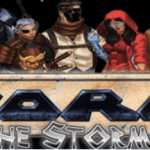
This month we enter the fascinating world of TORG, with the Savage Worlds system, where six brave adventurers cross worlds in their quest to defend the multiverse. GM Elvathadrin will take us through his game, Torg Rise of the Storm Knights and tell us a little about the process he has with his players to bring their stories to life.

First off, feel free to tell us about the person behind the GM screen. Where are you from? What do you do aside from gaming? Alter Egos? Life partners? Family? Where can we interact with you on the internet?
I am from New Jersey, lived here my whole life, don’t really have much of an online presence even though I am on the Obsidian Portal Discord. Outside of gaming, I enjoy hanging out with my friends watching movies. I also paint miniatures and when I can play miniature based games like Warhammer 40K and Xwing, I also play World of Warcraft, and Star Wars the Old Republic/this is the game I also RP most evenings in, and have for quite a few years.
Let’s talk about the visualization of your campaign. Did you make the animated banner yourself? And the video? What made you decide to place this video on your campaign’s landing page? Why did you decide to explain about your campaign in such a way? Are you the person speaking in the video?
The Banner was created by one of my good friends who’s also a player in my game. To be honest I found the video on YouTube, and why did I put it on the Landing page because after watching it I found it explained the universe of TORG perfectly, in an easy to understand and concise manner. I am not the person speaking in the video.
Is the narrator in the video meant to be the same person quoted in the description on the landing page?
The narrator in the video is not mean to be the same person quoted on the landing page, the man quoted on the page is an unknown individual that saw the initial events with his own eyes and lived the tell his tale.
I noticed that there was over a year’s time gap between your original start date in July 2021, and the next adventure entry in January 2023. What was the cause of this gap?
This is an easy question to answer, I started to work on the website a good year plus before the game we were playing ended, and I knew I had a lot of information I wanted to impart to my players, and knew it was going to take time to put it up and make it easy to read.
I see that you are using the Savage Worlds system. Can you please talk about what made you choose this system? How does the system support the campaign design and your game style?
I chose Savage Worlds because I was talking to a few of my friends about wanting to run a TORG game as I love the universe but not a fan of the system it uses, so they brought up Savage Worlds. The system in question is designed to be extremely malleable, and since TORG’s universe requires the ability to meld multiple of genres and make them fit with each other, Savage Worlds was perfect as it already did that so it made things easy to fit everything together without one overpowering the others. Savage Worlds had already put out different books that where all designed to work together from the beginning so it made it that much easier.
You seem to be integrating many characters from movies, tv, etc. Can you tell us a little about how you bring these characters to life? Do you study them from their respective franchises? Do you try to imitate their mannerism/voice?
Most of the characters I use are from TV shows and or games that I and most of my friends have already watched so they already know these characters, I do try to keep them in character and how they react and or help the group with their expertise in relationship to the universe itself.
At no point do I try to imitate their mannerisms or voices as I know I would never be able to do them justice.
How do the players contribute to the world design, if at all?
My players helped me with ideas for some of the new COSMS I have introduced into my universe that are not in base TORG, the ones they helped with where The Galactic Empire, The Big Heat, The Holy Roman Empire, Middle Westeros and The Main.
I see that you have a very detailed wiki section. How helpful is the Wiki for your players?
From what my players have told me it is extremely helpful, as it is referenced at least once most sessions, especially when they go into a new COSMs, the maps I created have also been extremely helpful to give my players an idea of where they are.
Can you please tell us why you choose to open each adventure log with a “wild cards” section which seems to include all the PCs? What is its meaning?
The reason I include the PC names is similar to the reason a TV show has credits, to remind the reader who the characters are in each session and if anyone new reads any Adventure log they know who was involved.
If you had to pick just one thing, what would you say Obsidian Portal helps you with the most?
Obsidian Portal helps with keeping all the information in one place and helps make it easy to find, if it wasn’t for the site I would never have been able to run this game.
What would you say is the biggest highlight of your game so far?
That is not the easiest of questions, but if I have to choose one, I would say the group was going after a Forest Dragon in Aysle the Fantasy COSM, the dragon preferred to hang out under water, so David the mad scientist of the group decided to create primitive depth charges. The idea was to drop them from the Quinjet.
While he was creating them, he created three by the way, the first and third where created without a hitch, unknown to anyone, David made a not so minor mistake on the second depth charge. When they went to use them, the first dropped fine and hit the water as it was supposed to, as they were getting ready to get the second in place the jostling caused it to explode prematurely while still inside the Quinjet, causing the jet to take a nose dive forcing Astoron to re-right the jet before it crashed, unfortunately he disconnected and completely froze forcing Ellistrae to quickly jump into action and right the jet. David the one that created the depth charge took the quick action to jump on the charge hoping to contain the blast, he succeeded in containing the blast not the concussive force that caused the jet to take a nose dive.
Okay, as a last question, we always ask for the GM’s “pearls of wisdom”. What GM insights can you offer the community this month?
I am still a fairly new GM, as I have only GMd four games, so most of my wisdom comes from that, I would say for those afraid to GM for the first time, don’t be afraid, because you will make mistakes, you will stumble as a GM, not everything you do is going to work, your players are going to throw monkey wrenches in your plans, from my experience, let them.. This is a collaborative effort, if your players come up with an off the wall idea, let them do it. It will make the game that much more fun and memorable.
Always remember you are the story teller, and it’s supposed to be fun for everyone, keep a light hand, don’t be heavy handed with your rulings.In the end as a GM always learn from your mistakes, because no matter how many games you run, you are still going to make them.
That’s all for this month folks! Don’t forget to head on over the the OP forums to nominate your favorite campaigns for our next Campaign of the Month!


